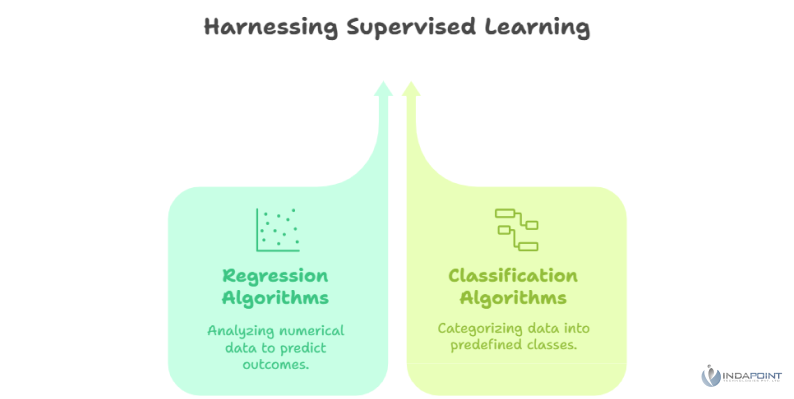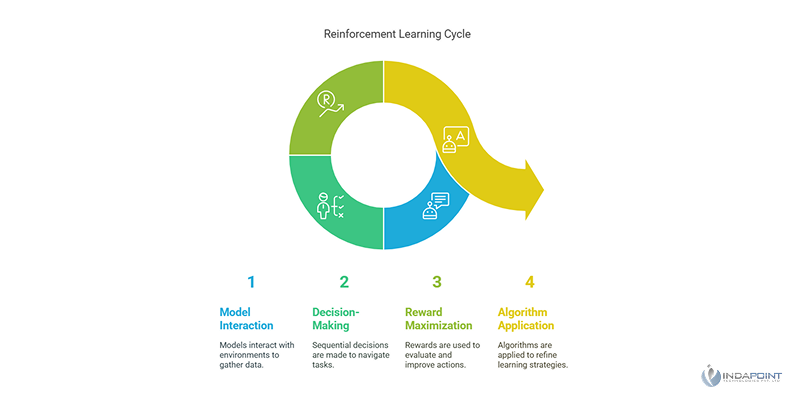Unlocking Business Potential with Machine Learning: A Comprehensive Guide to Algorithms and Real-world Use Cases
March 18, 2025

Machine learning is transforming businesses by enabling intelligent decision-making with minimal human intervention. This guide explores essential ML algorithms, including Supervised, Unsupervised, Reinforcement Learning, Neural Networks, and Ensemble Learning. It explains how these technologies work and their real-world applications, such as customer segmentation, dynamic pricing, image recognition, fraud detection, and predictive analytics.
Unlocking Business Potential with Machine Learning: A Comprehensive Guide to Algorithms and Real-world Use Cases
Machine learning has become a powerful technological tool, reshaping businesses globally. It enables systems to automatically learn from data, identify patterns, and make intelligent decisions with minimal human intervention. In this article, we dive deep into the essential ML algorithms, explore their underlying technologies, and illustrate practical business use cases.
1. Supervised Learning

- Concept:Supervised learning involves training an ML model using labelled datasets, where input-output pairs are provided. It predicts outcomes for new data based on learned relationships.
- Technology:Common algorithms include regression (linear, Polynomial, Ridge, Lasso) and classification (Logistic Regression, naive Bayes, K-nearest neighbours, SVM, and Decision Trees).
Business Use Cases:
- Regression:Used in forecasting sales, predicting housing prices (Real Estate), and estimating customer lifetime value (Retail).
- Classification:Used in email spam detection, customer churn prediction (Telecom), and medical diagnosis (Healthcare).
2. Unsupervised Learning
- Concept:Unsupervised learning extracts hidden patterns from unlabeled data, grouping data points based on similarity without predefined categories.
- Technology:Key algorithms include Clustering (K-Means, Mean Shift, DBSCAN, Agglomerative), Dimensionality Reduction (PCA, t-SNE, SVD), and Association Rule Learning (Apriori, FP-Growth).
Business Use Cases:
- Clustering:Customer segmentation (Marketing), fraud detection (Banking), and recommendation engines (E-commerce).
- Dimensionality Reduction:Feature selection for improving model performance, image compression, and data visualisation.
- Association Rule Learning:Market basket analysis (Retail), cross-selling and upselling strategies.
3. Reinforcement Learning

- Concept:Reinforcement learning (RL) involves training models through interaction with environments, maximising rewards through sequential decision-making.
- Technology:RL algorithms include Q-Learning, SARSA, Deep Q-Networks (DQN), A3C, and Genetic Algorithms.
Business Use Cases:
- Dynamic Pricing:Adjusting prices in real-time to optimise profitability (Travel & Hospitality).
- Robotics & Automation:Training robots for automated warehouse operations (Logistics).
- Financial Trading:Automating trading decisions for stock portfolios and risk management.
4. Neural Networks and Deep Learning
- Concept:Neural Networks simulate human brain functioning to process complex data patterns. Deep Learning, a subset, involves multi-layered networks capable of sophisticated pattern recognition.
- Technology:Key algorithms include CNNs (Convolutional Neural Networks), RNNs (Recurrent Neural Networks, including LSTM and GRU), GANs (Generative Adversarial Networks), Autoencoders, and Seq2seq models.
Business Use Cases:
- CNN:Image and video recognition systems (Social Media platforms), autonomous driving (Automotive).
- RNN/LSTM:Natural language processing applications like chatbots and speech recognition (Customer Service).
- GANs:Creating realistic synthetic data for training models, video game design, and creative advertising.
- Autoencoders:Anomaly detection in financial transactions (Banking) and recommendation systems.
5. Ensemble Learning
- Concept:Ensemble learning combines multiple models to enhance overall prediction accuracy by reducing errors.
- Technology:Prominent ensemble methods include Bagging (Random Forest), Boosting (AdaBoost, Gradient Boosting: XGBoost, LightGBM, CatBoost), and Stacking.
Business Use Cases:
- Random Forest:Predicting customer behaviour (Marketing) and credit risk assessment (Finance).
- Boosting:Fraud detection (Financial Services), demand forecasting (Supply Chain).
- Stacking:Enhancing prediction accuracy in competitive machine learning tasks, like stock price prediction.
When to Use Specific Algorithms?
- Supervised Learning:Use when historically labelled data is plentiful, and you need specific predictions.
- Unsupervised Learning:Ideal when you have extensive unlabeled data and wish to identify patterns or groupings.
- Reinforcement Learning:It is best when a transparent environment or feedback loop exists, allowing trial-and-error learning for sequential decisions.
- Neural Networks & Deep Learning:Suitable for complex, large-scale data tasks, particularly involving images, text, or unstructured data.
- Ensemble Learning:Useful for increasing accuracy and robustness, especially in competitive, precision-demanding environments.
Conclusion
Adopting appropriate Machine Learning algorithms can significantly enhance operational efficiency, customer experience, and strategic decision-making across diverse industries. By understanding each approach’s strengths and real-world applications, businesses can unlock new opportunities and achieve sustained competitive advantage.
Ready to harness the power of Machine Learning for your business? Our experts can help you identify the right algorithms to optimize your processes, enhance customer experiences, and gain a competitive edge. Whether it’s predictive analytics, image recognition, or dynamic pricing, we’ve got you covered. Contact us today to unlock your business’s true potential with cutting-edge ML solutions.





